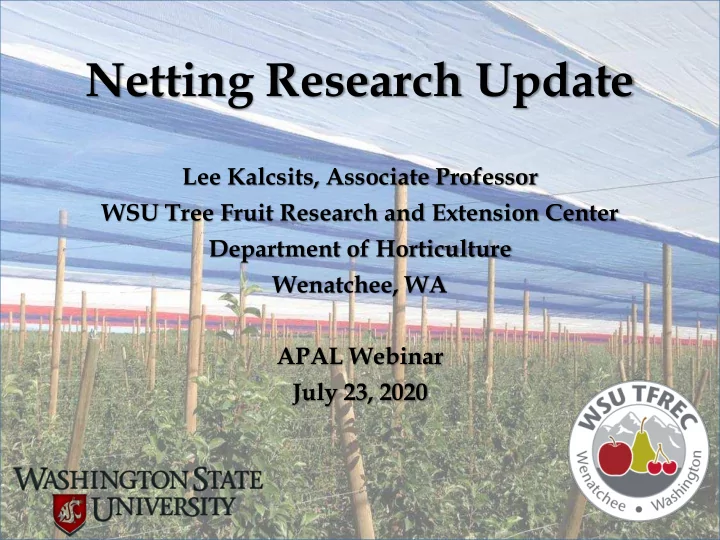

Netting Research Update Lee Kalcsits, Associate Professor WSU Tree Fruit Research and Extension Center Department of Horticulture Wenatchee, WA APAL Webinar July 23, 2020
Example: Protective Netting in Fruit Production Overview Design Hail/Sunburn Environment Fruit Quality Physiology Considerations
Protective Netting in Fruit Production Reducing Hail Damage 90 80% 80 Fruit damaged by hail (%) 70 60 50 40 30 20 10 3% 1% 0 Exclusion net Drape net Control Treatment Photo credit: S. Musacchi • Protective netting also acts as a physical barrier against hail • Hail damage reduced from 80% in the control to 3% and 1% under drape net and exclusion net respectively (Schmidt, 2014)
Protective Netting in Fruit Production Reducing Hail Damage
Protective Netting in Fruit Production Apple Sunburn (Racsko and Schrader, (Racsko and Schrader, 2012) 2012)
Protective Netting in Fruit Production Apple Sunburn Management • The largest contributor to fruit losses in Washington State Approximately 10% •
Protective Netting in Fruit Production Changes in Sunburn Risk S. Europe = 0 -> 27 MW = 3 -> 46 PNW = 25 -> 60 NE = 2 -> 30 SA = 7 -> 52 AUS = 11 -> 54 Days per year above 95°F 5 50 100 200
Protective Netting in Fruit Production Overview Design Hail/Sunburn Environment Fruit Quality Physiology Considerations
Protective Netting in Fruit Production Light Intensity and Wind Speed Table 1. Mean light intensity and wind speed for Blue, Pearl and Red netting compared to an uncovered control (84 days). Letters indicate significant difference determined by Tukey’s HSD test. 5 Light Intensity Wind Speed 4.5 (umol m -2 s -1 ) (km h -1 ) 4 Wnid Speed (km h -1 ) 3.5 Control 1804 a 6.03 a 3 2.5 Blue 1404 b 3.76 b 2 1.5 Control Pearl 1459 b 3.96 b Pearl 1 Blue 0.5 Red 1355 b 3.64 b Red 0 10-May 29-Jun 18-Aug 7-Oct
Protective Netting in Fruit Production Diffuse Lighting Light Scattering
Protective Netting in Fruit Production Overview Design Hail/Sunburn Environment Fruit Quality Physiology Considerations
Protective Netting in Fruit Production Fruit Sunburn (Honeycrisp) - 2015 Blue Red High Grade Reduced-Grade Cull Pearl Control
Protective Netting in Fruit Production Fruit Size Average fruit size (g) for fruit harvested from under pearl, blue and pearl netting compared to an uncovered control 2015 2016 Control 231 a 366 a Pearl 274 c 394 b Blue 252 b 388 b Red 260 bc 386 b
Protective Netting in Fruit Production Fruit Quality Fruit red color development and soluble sugars content (Brix) in Honeycrisp apple under pearl, blue and red netting compared to an • When fruit size is uncovered control. 2 = 50% red color. accounted for, there SSC ( ° Brix) are more sugars per 15.0 a Control fruit netting Pearl 14.7 ab compared to the Blue 14.5 b uncovered control. Red 14.5 b • Color development Fruit red color development in Honeycrisp apple in 2015 and 2016 under netting compared to an uncovered control. 2 = 50% red was better in 2015 color. compared to 2016. 2015 2016 Uncovered trees had Control 2.77 a 2.30 a slightly better color in Netted 2.52 b 2.25 a 2015 compared to netted trees.
Protective Netting in Fruit Production Overview Design Hail/Sunburn Environment Fruit Quality Physiology Considerations
Protective Netting in Fruit Production Physiology
Protective Netting in Fruit Production Improving canopy in-fill 14 12 Shoot Growth (Inches) 10 8 6 4 2 0 Control Netting
Protective Netting in Fruit Production Sap Flow Under Netting Light Use Efficiency Photosynthesis 0.6 25 Net CO 2 Exchange (µmol m -2 s - Quantum Yield of Photosystem II (P) 0.5 20 0.4 15 0.3 10 0.2 1 ) 5 0.1 0 0 Honeycrisp Honeycrisp
Protective Netting in Fruit Production Sap Flow Under Netting 500 Tree Water Use (mL H 2 O 15 Netting 400 evaporation (mm d -1 ) Control Cummulative 300 10 hr -1 ) 200 100 5 0 Control 0 28-Jul 29-Jul 30-Jul 31-Jul 1-Aug Time of Day Date
Protective Netting in Fruit Production Overview Design Hail/Sunburn Environment Fruit Quality Physiology Considerations
Protective Netting in Fruit Production Continuous Over-the-Top Structure • Most common netting structure used by growers in WA
Protective Netting in Fruit Production Exclusion netting (both top and sides) Exclusion Netting • Exclusion netting offers the most protection and can be used on sites where wind damage is a higher risk
Protective Netting in Fruit Production Louvre Netting • Most effective in a north-south tree row orientation; protection to the west side of the tree that is exposed to damaging solar radiation in the afternoon
Protective Netting in Fruit Production Drape Netting • Easiest to deploy • Lowest cost • Most difficult to work under • No superstructure
Protective Netting in Fruit Production Considerations • Labor for deployment and retraction • Post-bloom and post-harvest • Design – Retrofit or in new orchards • Retrofitting is much more expensive and labor intensive…plan ahead • Engineering • Essential!
Protective Netting in Fruit Production Summary Positives Negatives Improve sizing and quality Disease pressure?? Reduced water-use Labor to deploy and retract Increased Canopy Infill Slight reductions in color development Reduced Sunburn Costs Hail Protection
Questions? Kalcsits Lab Crew - 2018 Back Row (L to R): Lee Kalcsits, Ryan Mullin, Jack Gavin, Giverson Mupambi, Chloe Smythman, Hector Camargo-Alvarez Front row (L to R): Erica Casagrande Biasuz, Brenda Castaneda, Michelle Reid, Katie Mullin, Sumyya Waliullah, Nadia Valverdi, Raquel Gomez
Recommend
More recommend